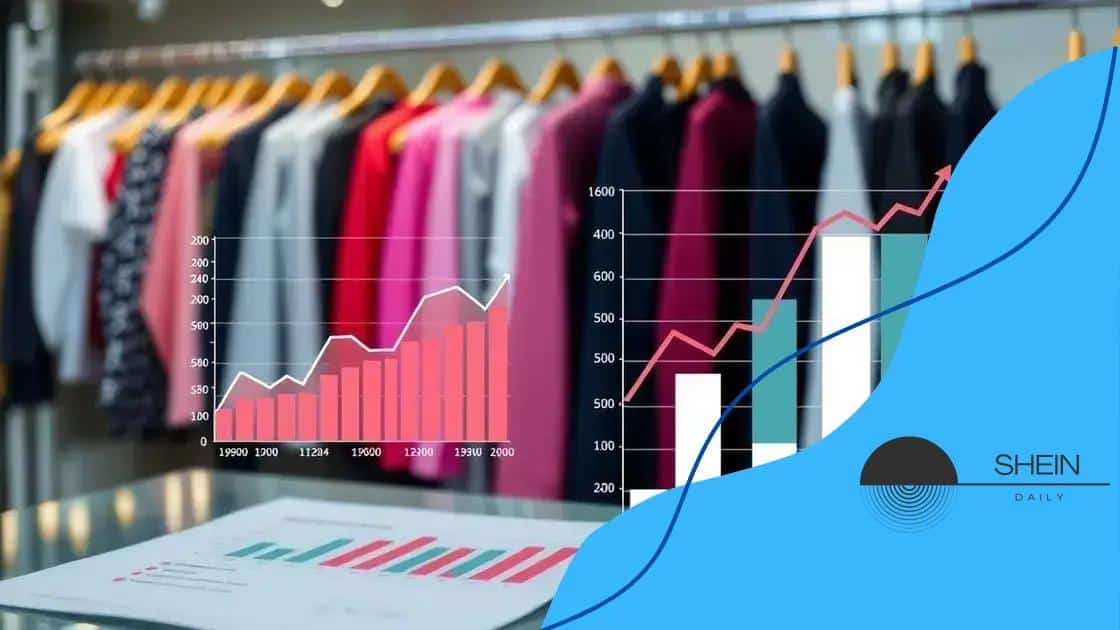How Shein balances fast fashion with sustainability

Shein balances fast fashion with financial sustainability by adopting eco-friendly materials, optimizing production processes, and responding to consumer demands for transparency and ethical practices.
How Shein balances fast fashion with financial sustainability is a question many consumers ask as they shop. With the rise of ethical fashion, it’s intriguing to understand how this brand navigates its business model while remaining profitable. Let’s dive into their strategies and practices.
Understanding fast fashion and its impact
Fast fashion has changed the way we shop and consume clothing. It refers to the rapid production of inexpensive clothing in response to the latest trends. This approach not only makes fashion accessible but also raises questions about its impact on the environment and economy.
What is fast fashion?
Fast fashion brands quickly create collections inspired by runway shows or celebrity styles. This speed allows consumers to purchase trendy items at lower prices. However, this model often leads to overconsumption and waste.
The environmental impact
The environmental impact of fast fashion is significant. The production processes consume large amounts of water and energy, contributing to pollution. Additionally, discarded clothing often ends up in landfills, creating a waste crisis.
- Water usage: Fast fashion requires about 2,700 liters of water per shirt
- Pollution: Chemicals used in production contaminate local water supplies
- Waste: Millions of tons of clothing are thrown away each year
These factors showcase the pressing need for more sustainable practices in the fashion industry. Moreover, consumers are becoming more aware of these issues, prompting demand for change.
Besides environmental consequences, fast fashion impacts economies. While it creates jobs in developing countries, many workers face poor working conditions and low wages. Companies often prioritize profit over worker rights, leading to exploitation.
Consumer awareness
As shoppers recognize these issues, they are increasingly looking for brands that prioritize sustainability. This shift can influence how companies like Shein operate. By incorporating eco-friendly practices, they can attract a more conscious consumer base.
How Shein incorporates sustainable practices
Shein is making strides in the fashion industry by adopting sustainable practices. This is essential for balancing their business model with the growing demand for environmentally friendly options.
Eco-friendly materials
One way Shein incorporates sustainability is by using eco-friendly materials. They are exploring fabrics made from recycled plastics and organic cotton, which significantly reduce environmental impact.
- Recycled materials: Utilizing plastic bottles to create fabric
- Organic cotton: Reducing pesticide use and conserving water
- Sustainable sourcing: Working with suppliers who practice sustainability
These materials not only help the planet but also meet consumer preferences for more responsible fashion. As more shoppers seek sustainable options, Shein’s initiatives are timely.
Innovative production processes
Shein is also innovating in its production processes. They are adopting models that allow for on-demand production, which minimizes waste. Instead of producing large quantities of clothing, they create items as needed.
This approach reduces excess inventory and contributes to a more sustainable cycle. Moreover, Shein is investing in technology that enhances efficiency in making designs, which helps them align better with sustainable practices.
Consumer transparency is another focus area. Shein is providing information about their sustainability efforts, allowing shoppers to make informed choices. By educating consumers about their sustainable options, they create a dialogue around fashion responsibility.
The financial strategies of Shein

Shein’s financial strategies play a crucial role in maintaining its position in the fast fashion industry. By focusing on several key methods, the company effectively balances profitability and sustainability.
Cost-effective production
One significant strategy is Shein’s cost-effective production model. They leverage technology and data analytics to streamline operations. This allows them to produce fashionable items at lower costs.
- Data-driven decisions: Analyzing consumer trends to create targeted collections
- Efficient supply chain: Maintaining strong relationships with suppliers for better pricing
- In-house production: Reducing outsourcing to control costs and quality
This approach not only saves money but also maximizes output, ensuring that Shein stays relevant in a fast-paced market.
Dynamic pricing strategies
Another key aspect of Shein’s financial strategies is dynamic pricing. They adjust prices based on demand, allowing them to stay competitive while appealing to a broad audience.
This flexibility attracts customers looking for affordable options without sacrificing style. By analyzing market trends, Shein can optimize pricing to maximize sales while maintaining profit margins. This approach is especially effective during promotions and sales events.
Shein also invests in marketing strategies that promote these financial practices. By utilizing social media and influencer partnerships, they reach their target audience effectively, driving sales and brand loyalty.
Consumer perception and sustainability
Consumer perception plays a vital role in shaping the landscape of sustainability in fashion. As awareness of environmental issues grows, many shoppers are rethinking their buying habits.
Rising awareness
Today, consumers are more informed about the impacts of their purchases. They understand that fast fashion can lead to significant waste and pollution. This growing awareness is prompting many to seek brands that prioritize sustainability.
- Ethical considerations: Consumers want to support companies that practice fair labor.
- Environmental impact: Shoppers are concerned about the effects of clothing production on the planet.
- Transparency: Brands that openly communicate their practices tend to gain trust.
As companies like Shein promote their sustainable practices, they tap into this heightened consumer sensitivity. Providing details about sourcing and manufacturing can impress potential buyers.
Influence of social media
Social media has significantly impacted consumer perception. With platforms like Instagram and TikTok, brands can showcase sustainable practices in engaging ways. Influencers often highlight eco-friendly products, making sustainability a trendy topic.
This trend not only elevates consumer interest in sustainable fashion but also encourages brands to adopt more responsible practices. Shein, for example, has collaborated with influencers to promote their eco-conscious efforts, capturing the attention of new audiences.
As consumers increasingly demand sustainability, brands must adapt to meet these expectations. Companies that ignore this shift risk losing the support of their customer base, as more shoppers choose to invest in brands that align with their values.
Future challenges for Shein
Shein faces various future challenges as it navigates the ever-evolving fashion landscape. With growing consumer awareness and a focus on sustainability, the brand must adapt to remain competitive.
Adopting sustainable practices
One major challenge is the need to further adopt sustainable practices. As consumers expect brands to prioritize the environment, Shein must find ways to reduce its carbon footprint. Implementing eco-friendly production methods and sourcing sustainable materials are essential steps.
- Increasing transparency: Customers want to see how their clothes are made.
- Reducing waste: Finding solutions to minimize unsold inventory and textile waste.
- Implementing circular fashion: Incorporating recycling and upcycling into the business model.
By addressing these areas, Shein can enhance its reputation and appeal to a broader audience.
Regulatory pressures
Another challenge comes from regulatory pressures. Governments are increasingly enacting laws aimed at reducing environmental impact. Shein must comply with these regulations, which may require significant changes to their operations. Adjusting to new standards can be costly and complex.
This shift not only impacts production but also influences supply chain management. Companies will have to rethink sourcing and logistics to align with stricter regulations.
Maintaining brand loyalty
Brand loyalty is another area Shein must focus on. As sustainability becomes a key concern, competitors are emerging with stronger eco-friendly initiatives. Shein must continue to innovate and engage with consumers to keep them loyal. This involves not just marketing campaigns, but also demonstrating real change and commitment to sustainable practices.
By addressing these challenges head-on, Shein can secure its place as a leader in the fast fashion industry while meeting the demands of modern consumers.
FAQ – Frequently Asked Questions about Shein and Sustainability
What are Shein’s main sustainable practices?
Shein focuses on using eco-friendly materials, reducing waste, and adopting on-demand production to minimize environmental impact.
How does consumer perception affect Shein’s sustainability efforts?
As consumers become more aware of environmental issues, they increasingly prefer brands that demonstrate transparency and sustainability.
What challenges does Shein face regarding regulations?
Shein must adapt to new environmental regulations, which may require changes in their production processes and sourcing.
How can Shein maintain brand loyalty among eco-conscious consumers?
By actively promoting its sustainability initiatives and engaging with consumers, Shein can build trust and loyalty among eco-conscious shoppers.





